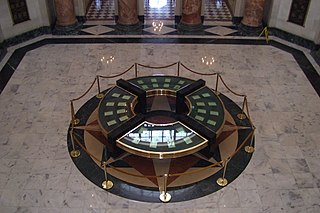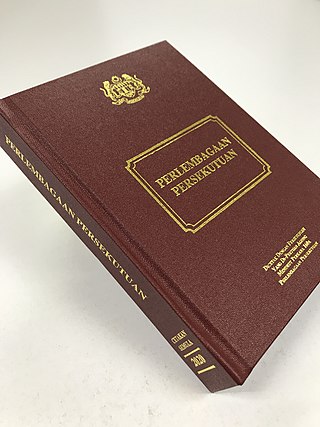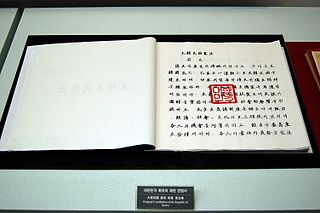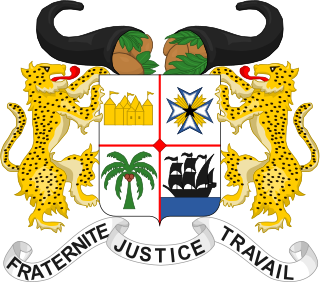
The Constitution of Ireland is the fundamental law of Ireland. It asserts the national sovereignty of the Irish people. The constitution, based on a system of representative democracy, is broadly within the tradition of liberal democracy. It guarantees certain fundamental rights, along with a popularly elected non-executive president, a bicameral parliament, a separation of powers and judicial review.

The Constitution of the Confederate States was the supreme law of the Confederate States of America. It superseded the Provisional Constitution of the Confederate States, the nation's first constitution, in 1862. It remained in effect until the end of the American Civil War in 1865.

The Constitution of East Germany refers to the constitution of the German Democratic Republic, commonly known as East Germany. Its original constitution was promulgated on 7 October 1949. It was heavily based on the "Weimarer Reichsverfassung", and nominally established the GDR as a liberal democratic republic. In 1968 the East German government adopted a new, fully Communist constitution that was based on Marxism-Leninism, political unitarism, and collective leadership. There were further amendments to the 1968 constitution in 1974. With the political events of 1989, there were attempts to draft a new constitution for East Germany, but these efforts never materialized due to the dissolution of East Germany and the accession of its Länder into the neighboring Federal Republic.

The Constitution of the Commonwealth of Puerto Rico is the controlling government document of Puerto Rico. It is composed of nine articles detailing the structure of the government as well as the function of several of its institutions. The document also contains an extensive and specific bill of rights. It was ratified by Puerto Rico's electorate in a referendum on March 3, 1952, and on July 25, 1952, Governor Luis Muñoz Marín proclaimed that the constitution was in effect. July 25 is known as Constitution Day.

The Federal Constitution of Malaysia, which came into force in 1957 as the Constitution of the Federation of Malaya and was amended in 1963 to form the Constitution of Malaysia, is the supreme law of Malaysia and contains a total of 183 articles. It is a written legal document influenced by two previous documents, the Federation of Malaya Agreement 1948 and the Independence Constitution of 1957. The Federation was initially called the Federation of Malaya and it adopted its present name, Malaysia, when the states of Sabah, Sarawak and Singapore became part of the Federation. The Constitution establishes the Federation as a constitutional monarchy, having the Yang di-Pertuan Agong as the Head of State with largely ceremonial roles. It provides for the establishment and organisation of three main branches of the government: the bicameral legislative branch called the Parliament, which consists of the House of Representatives and the Senate ; the executive branch led by the Prime Minister and his Cabinet Ministers and the judicial branch headed by the Federal Court.

The Gülhane Hatt-ı Şerif or Tanzimât Fermânı was a proclamation by Ottoman Sultan Abdülmecid I in 1839 that launched the Tanzimât period of reforms and reorganization in the Ottoman Empire. The 125th anniversary of the edict was depicted on a former Turkish postcard stamp.

The Preamble to the United States Constitution, beginning with the words We the People, is a brief introductory statement of the US Constitution's fundamental purposes and guiding principles. Courts have referred to it as reliable evidence of the Founding Fathers' intentions regarding the Constitution's meaning and what they hoped the Constitution would achieve.
Article 153 of the Constitution of Malaysia grants the Yang di-Pertuan Agong responsibility for "safeguard[ing] the special position of the 'Malays' and natives of any of the States of Sabah and Sarawak and the legitimate interests of other communities" and goes on to specify ways to do this, such as establishing quotas for entry into the civil service, public scholarships and public education.

The Constitution of the Republic of Korea is the supreme law of South Korea. It was promulgated on July 17, 1948, and last revised on October 29, 1987.

The Constitution of the State of Illinois is the governing document of the state of Illinois. There have been four Illinois Constitutions; the fourth and current version was adopted in 1970. The current constitution is referred to as the "Constitution of Illinois of 1970" or less formally as the "1970 Constitution." The document is still referred to as the "Constitution of Illinois of 1970" even though there have been amendments to it after 1970. Important features of the 1970 Constitution include the creation of home rule powers for larger municipalities and other units of local government.

The Constitution of Belize is the supreme law of the nation of Belize. It was signed on September 1981 with effect from that date.
The Constitution of the State of Maine established the "State of Maine" in 1820 and is the fundamental governing document of the state. It consists of a Preamble and ten Articles (divisions), the first of which is a "Declaration of Rights".

The Constitution of Benin was adopted by referendum on 23 December 1956. The constitution is made up of a preamble, twelve titles, and 160 articles.

The Preamble to the Constitution of India presents the principles of the Constitution and indicates the sources of its authority. It was adopted on 26 November 1949 by the Constituent Assembly and came into effect on 26 January 1950, celebrated as the Republic Day of India. It was amended during the Indian emergency by Indira Gandhi where the words "socialist" and "secular" were added.

The Sarawak State Legislative Assembly is the legislative chamber of the unicameral legislature of the Malaysian state of Sarawak; the Yang di-Pertua Negeri of Sarawak forms the other part of the legislature. The Assembly is modelled after the traditions of the Westminster parliamentary system, which originates from the practices of the British Parliament. The executive branch of government is drawn from the elected members of the Assembly. The State Legislative Assembly sits at the Sarawak State Legislative Assembly Building located in Petra Jaya in Kuching, the state capital.

The anti-cession movement of Sarawak was a movement in Sarawak to fight against the British attempt to govern Sarawak as a crown colony rather than a protectorate ruled by the White Rajahs. The movement lasted from 1 July 1946 until March 1950.

The Crown Colony of Sarawak was a British Crown colony on the island of Borneo, established in 1946, shortly after the dissolution of the British Military Administration. It was succeeded as the state of Sarawak through the formation of the Federation of Malaysia on 16 September 1963.

The Proclamation of Malaysia was a statement, written in English and Malay, that declared the merger of the Federation of Malaya with the State of Singapore and the British crown colonies of North Borneo and Sarawak into the new Federation of Malaysia, following the enactment of the Malaysia Agreement and the Malaysia Act 1963 that July. The merger came into effect on 16 September 1963, and the proclamation was delivered on that date by Prime Minister Tunku Abdul Rahman in the Stadium Merdeka in Kuala Lumpur.

The 18-point agreement, or the 18-point memorandum, was a list of 18 points drawn up by Sarawak, proposing terms to form Malaysia, during negotiations prior to the creation of the new federation in 1963.
The 1941 constitution of Sarawak is the first known written constitution in the Raj of Sarawak in Borneo. Written in the English language, the Constitution was proclaimed by the then third white rajah of Sarawak, Charles Vyner Brooke on 24 September 1941, which ends the century of sole sovereignty of Brooke's rule and for the people of Sarawak to their own constitutional government.
















